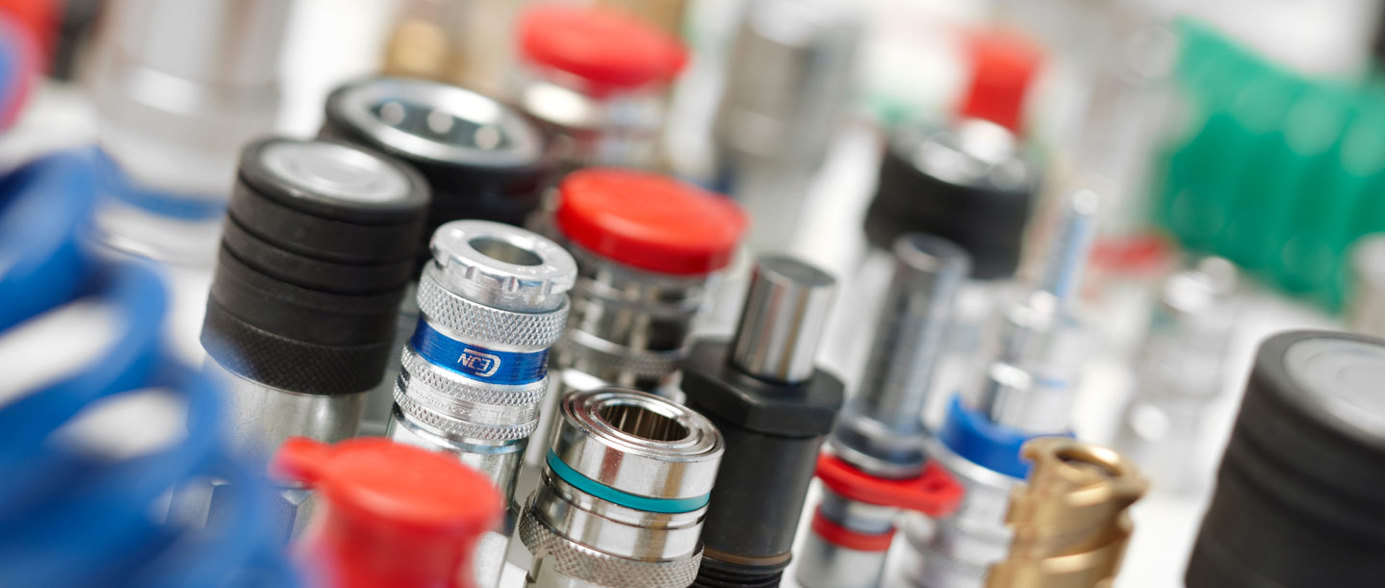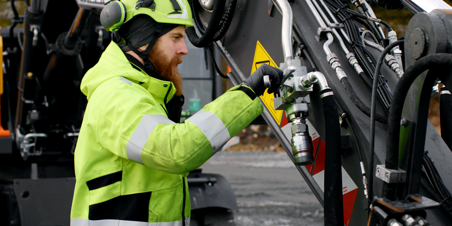What is S.T.A.M.P.E.D.? And why do you need to know it?

S.T.A.M.P.E.D. is an acronym which stands for: Size, Temperature, Application, Material/Media, Pressure, Ends, and Delivery. S.T.A.M.P.E.D. is an industry-wide practice used by engineers and operators as a guide when replacing or determining specs for new hydraulic and pneumatic (compressed air) hoses and fittings.
Although this method is most commonly used by purchasers and engineers looking to buy or source hydraulic/pneumatic hoses, this article will show how the S.T.A.M.P.E.D. method can be applied to the quick connect fittings in particular to ensure you install the best quick connect coupling for your hydraulic, fluid, or compressed air application.
Quick connect fundamentals
The fundamentals: Quick Connect fittings are used at the end of a hydraulic or compressed air hose to facilitate the connection and disconnection of an attachment without the use of tools. They are also referred to as: Quick Disconnects, Quick Couplings, Push to Connect / Push-on / Push-fit, Plug-in fittings, Quick Manifolds, and Quick Release Couplings.
Quick couplings are used in a wide variety of pneumatic/compressed air, hydraulic machinery, heating, electrical, and fluid transfer systems. There are a number of generic and proprietary push-fitting body styles and designs for sale, with the most popular being the ISO 16028 Series, Industrial quick connect interchange, the ARO quick connect interchange, and the Automotive quick connect interchange.
Often, the larger pieces of a system like the hydraulic pump or air compressor command the majority of a designer’s focus. Yet, the seemingly small quick connect fittings can have a large impact on the overall user experience, safety, serviceability (maintenance/repair), and efficiency/flow/volume of hydraulic and pneumatic systems. Quick connects come in a variety of sizes and body styles including flat-face (no-spill/spill free) and wing nut styles, poppet styles, screw-to-connect, dust caps, and plugs. The design of the quick connect is equally important to the material used in its construction. Common quick connect construction materials include metal (stainless steel, carbon steel, brass, aluminum, copper, zinc alloys), rubber, nylon and plastic (PP Polypropylene, PVC).
Since a pneumatic, fluid, or hydraulic system is only as strong as its weakest link, CEJN encourages using this 7-step S.T.A.M.P.E.D. method in the decision-making process when repairs or upgrades of male and/or female quick connect fittings are needed.
S is for Size
Size of the quick connects inside diameter (I.D.), and outside diameter (O.D.)
Why is size important for quick disconnects?
The inside diameter must be able to keep pressure loss to a minimum, maintain adequate flow and avoid damage to the hydraulic/pneumatic system due to heat generation or excessive turbulence. The flow rate, in conjunction with the inside diameter and design of the quick coupling, will determine the fluid velocity through the fitting. Manufacturers like CEJN can help by providing specific velocity/volume specs for the different quick connect couplers they supply.
Questions to start with:
- What inside diameter (ID) is needed for the quick connect?
- Is the outside diameter (OD) critical?
- Are other size/space limitations present for the fitting?
Note: Undersized quick connects and fittings can result in reduced flow rates of the hydraulic fluid or compressed air. The ensuing turbulence causes loss of pressure (i.e. Pressure drop, Pressure loss, or Delta P), noise and increased temperatures. Prolonged restrictions of the fluid or air can be damaging to the entire system.
T is for Temperature
Temperature of the material conveyed and environmental temperature
Why is temperature important when choosing a quick connect coupling?
Continuous operation at high temperatures can reduce the service life of the quick disconnect fittings. Fittings will have a longer service life if not continually used at the limits of their working pressure, and temperature specs as provided by the manufacturer of the quick disconnect.
The operating and ambient temperatures in which the fittings will be used have a considerable impact on the overall working pressure of the hydraulic, fluid, or compressed air system. Maximum working pressures will decrease as temperatures increase. Quick connects should be rated for levels recommended for the average, minimum and maximum operating temperatures the hydraulics/pneumatic system will endure. The temperature ratings for a quick connect fitting will vary based on material, metals, protective plating or coating, O-rings, and the seal material.
Questions to start with:
- What is the temperature range of the product being conveyed?
- What temperatures will the external cover be subject to?
- What is the maximum temperature the hydraulic/pneumatic fitting will be exposed to?
Note: Always consider maximum intermittent ambient temperature, fluid/hydraulic temperature, ambient temperature, maximum temperature and sub-zero exposure. When routing near hot manifolds, keep in mind that maximum assembly working pressures will decrease as temperatures increase. In extreme cases, a heat shield may be advisable.
* If flame resistance or flammability is of concern, it should be noted and accounted for in the design.
A is for Application
Application (the general conditions in which the quick connect will be used)
How is the application in which the quick connect will be used important?
The application for which the quick connect fitting is to be used includes things like the environment, potential for exceeding max pressure ratings, vibration, orientation and fitment. It also includes hydraulic or pneumatic (compressed air) attachments, ease of use, cycle life, and serviceability considerations.
Anticipated movements and rotations must be quantified, along with intermittent or prolonged periods of service, indoor and outdoor use, mechanical load surges, excessive vibration, electrical conductivity requirements, equipment type; plus external conditions, such as abrasion, oil, solvents, acid, chemicals, and salt water.
If an existing quick connect is being replaced, certain application attributes can be accounted for to help ensure a longer service life before installing a new quick connect coupler. These include a description of the failure, frequency of impulses, pressure spikes, and connection and disconnection cycles.
Questions to start with:
- Where will this hydraulic/pneumatic fitting be used?
- How will it be handled or installed?
- Will the connection points be rotated, dragged, or experience excessive vibrations?
- If replacing an existing fitting, why did the previous fitting fail?
Note: Consider asking yourself what would happen if the quick disconnect fitting was to fail on this application; Could the result be extensive injury or damage to property, personnel, machinery, or the environment?
M is for Material/Media
Material/Media being conveyed, type, concentration, and viscosity
Why is understanding the material used within a quick connect important?
Some applications require specialized fluids, gases, oils, or chemicals to be moved throughout the system. The components that make up the quick connect fittings must be capable of safely containing and effectively moving caustic and/or potentially toxic media. The quick disconnect fitting must be built with materials (i.e. metal, rubber, O-rings, plastics) capable of coming into contact with the media without compromising the integrity of the system.
System design specifications or regulatory agency requirements also need to be considered (e.g. USCG, FDA). It is also of value to know whether the material will flow continuously or sit in the system unused for longer periods of time. Prolonged contact with certain materials can react differently under pressure, with friction, and temperatures.
Questions to start with:
- What is the substance or material being conveyed through the fluid/hydraulic/pneumatic system?
- Is the material being conveyed corrosive, toxic, abrasive, etc.?
- Will the quick connect fitting be submerged or otherwise exposed to fluids, gases, or chemicals?
Note: Media velocity and flow rate, the chemical and concentration, abrasive nature, solids, description and size should be well documented and accounted for (tip: always keep a copy of the media’s MSDS/SDS Sheets). Also account for residual media that may be left in the system during operation as well as down time. Prolonged stagnant contact can affect the reactions between some medias and fitting metals, rubber, O-rings, and plastics are differently than seen during periods of use.
P is for Pressure
Pressures to which the quick connect will be exposed
Why is it important to know the pressures a quick connect fitting will be exposed to?
The pressure rating for the quick connect must be equal to or greater than the system pressure. Pressure spikes greater than the maximum working pressure can shorten the life span of the quick connect.
The maximum operating pressure is the maximum pressure that the system should be exposed to in normal operating conditions. The quick connect fitting should not be rated to a pressure less than the maximum operating pressure of the system. Frequent pressure spikes can have a negative impact on the longevity and durability of even the best of quick connect couplings.
Questions to start with:
- Is this a pressure or vacuum application?
- What is the maximum working pressure of your machine or compressor?
- Will the quick connects be exposed to any pressure surges/spikes?
Note: Never use a quick connect fitting for a system with pressures exceeding the pressure rating for the coupling. Temperatures inside and outside the system can affect the pressures within the system.
E is for Ends
Ends; Coupling design, style, type, and safety features
What should you look for to ensure quick connect fitment and compatibility?
Design for the terminal and thread type of your hydraulic or pneumatic system (i.e. male or female, angled, standard, metric, JIC thread, AN thread, BSP/BSPT thread, NPT thread, metric, ORFS, SAE, hose barb, gladhand, hose clamp, jubilee clip, etc.). If changing out a failed quick connect fitting, consider changing out terminal fitting types as well to best accommodate for the demands of your system. Hydraulic and pneumatic systems may have been expanded upon and can no longer can meet the volumetric flow rates needed without removal and replacement of the potentially restricting incumbent fittings. The pressures and volume flow demand of the system should dictate the thread types and connection methods used by the quick connect coupling and corresponding fittings.
Questions to start with:
- What type of thread should be used for the application?
- Are the metals of the fitting and threads compatible? (carbon steel, brass, stainless steel)
Note: Remember that the weakest link and greatest potential for failure is typically found where the hose and fitting meet, or within the connecting fitting itself. To protect from accidental disconnection for hydraulic and pneumatic high-pressure systems, a safety-locking quick connect should be installed to make disconnection of the fitting deliberate.
D is for Delivery
Delivery; Testing, quality, packaging, and timing
How can the delivery affect you and the operating system?
Deliveries are specific to one’s testing requirements, certification requirements (USCG, CRN, CGA), special packaging and shipping requirements, and/or tagging/packaging needs.
Questions to start with:
- When will you need the quick connect?
- What is the cost of downtime of the system?
- How much time will it take for the manufacturer to deliver the necessary part(s)?
- How long will installation/assembly of the new quick connect fitting take?
Note: Once a quick connect has been put into service, CEJN recommends regular inspections. All parts of the system should be treated as a potential hazard. Always use the optimum quick connect available for your hydraulic or compressed air system to reduce downtime.
Related Stories

Step-by-step guide: How to change the seal on CEJN TLX coupling
Using products that last is a sustainable choice for both the wallet and the planet. Rather than disposing of a product once it reaches the end of its service life, we offer a wide range of spare...

Step-by-step guide: How to install CEJN TLX on hydraulic attachments
In heavy-duty applications, the failure of quick-connect couplings often comes from high surge flows. These surges can lead to seal failures and machine damage, resulting in costly leakages and machine downtime. CEJN TLX is a super-duty coupling solution specifically designed to withstand the...

Compressed air optimisation: 5 common leak sources in compressed air systems
Compressed air systems offer a versatile and efficient power source within many industries. High reliability and a favourable cost/performance ratio have kept the compressed air solutions a top...